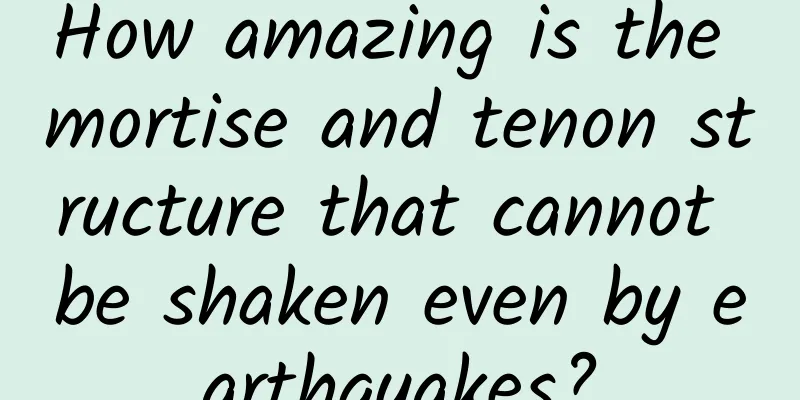How amazing is the mortise and tenon structure that cannot be shaken even by earthquakes?

|
In the 20th century, there were three earthquakes with a magnitude of 8.6 or above in the world, two of which occurred in my country. However, many ancient buildings have withstood the test, and their main structures remain intact, thanks to the widespread use of mortise and tenon structures in ancient buildings. Are you curious about why this mysterious mortise and tenon structure can give buildings such amazing earthquake resistance? Well, let's step into the world of "mortise and tenon" and find out! 1. Chinese wisdom of combining hardness and softness The mortise and tenon structure is a structure used to connect wood in traditional Chinese craftsmanship. The protruding part is called the "tenon" and the recessed part is called the "mortise". Now that we have figured out the names, let's take a look at why they are so strong without a single nail. Material properties: Wood materials generally have a longitudinally arranged avant-garde structure. This characteristic makes the strength and toughness of the material concentrated in the longitudinal direction, while the transverse direction is relatively weak. The mortise and tenon structure is based on this characteristic of wood, converting part of the transverse force to the longitudinal direction, and using the longitudinal strength and toughness to support the force, which can be said to be "strengthening strengths and avoiding weaknesses" to the extreme. Secondly, unlike items that are made with metal nails at the joints, the mortise and tenon structures are made of the same material. When the temperature and humidity of the environment change, their own expansion and contraction degrees are the same. The wood at both ends of the connection will shrink or expand together, making the overall structure more solid and avoiding the situation where the service life is shortened due to loose connections. Production technique: The mortise and tenon structure has complex craftsmanship and diverse construction methods. The concave and convex surfaces bite into each other, which can greatly improve the load-bearing capacity of the joint, even greater than the wood material itself. 2. Proven seismic performance my country is a country with many earthquakes. It is located between the Pacific Rim and the Eurasian Seismic Belt. The earthquake activity is frequent, strong, shallow and widely distributed. In the 20th century, there were three earthquakes with a magnitude of 8.6 or above in the world, two of which occurred in my country. However, many ancient buildings have been able to withstand the test of time, and the main frame structure remains intact, thanks to the widespread application of mortise and tenon structure in ancient buildings. The most typical example is the Yingxian Wooden Pagoda, which has a history of nearly 1,000 years. The tower was built in the second year of Qingning in the Liao Dynasty (1056 AD) and is the oldest existing wooden tower building in my country. After the baptism of earthquakes and wars, it still stands proudly today. In addition to the regular octagonal plane design that can withstand the torque of earthquake waves and the solid brick and stone base, a more important reason is that the brackets between the beams and columns in the tower are connected by mortise and tenon structures. China Science and Technology Museum Exhibits: Yingxian Wooden Pagoda Relevant data show that there are as many as 62 places where mortise and tenon joints are used in the Yingxian Wooden Pagoda, and there are 54 types of brackets. These mortise and tenon structures make the connection in a semi-consolidated and semi-live hinge state, which can withstand greater bending moments. At the same time, when attacked by vertical shock waves in earthquake waves, the mortise and tenon components can also dissipate huge destructive energy by "bouncing". In addition, the mortise and tenon joints connect the entire building into a cylindrical frame structure, which can effectively resist rotation waves and increase the overall stability of the building. Therefore, the mortise and tenon structure without a single nail or rivet can really achieve "ten thousand years of firmness". 3. Mortise and tenon structure in modern architecture Since mortise and tenon joints are difficult to mass produce by making simple molds and have high labor costs, they are rarely seen in modern architecture and furniture. However, in recent years, mortise and tenon joints have regained people's attention and favor with their exquisite design and stable characteristics. At the 2010 Shanghai World Expo, the China National Pavilion, which was full of Chinese style, had its load-bearing components made using the mortise and tenon technology. The eaves were cantilevered and stacked layer by layer, transferring the eaves force evenly to the columns, ultimately forming the traditional "douguan" shape of Chinese wooden architecture. The world-renowned "Crown of the East" was born. China National Pavilion "Crown of the East" Equally representative is the new China Science and Technology Museum, which is just a stone's throw away from the Bird's Nest. The entire building is square in shape, consisting of several building block-like blocks interlocking with each other. It looks like a giant version of the "Lu Ban Lock" we played with when we were children. It not only embodies the traditional Chinese cultural concept of emphasizing the combination of the whole and the parts, but also implies the integration and mutual promotion of various disciplines. The ingenuity of the ancients is of great reference value for modern design, and the craftsmanship implied behind the mortise and tenon structure is even more worthy of learning for all of us at present. Through improvement and flexible application, we can let traditional culture shine again. References: "On the Mortise and Tenon Structures and Their Anti-Seismic Functions in Ancient Buildings" Global Human Geography Magazine "Advantages of using mortise and tenon joint structures of ancient Chinese buildings in earthquake zones" Modern decoration (theory) "Inheritance and development of mortise and tenon structure in wooden buildings" Forest Products Industry |
<<: What kind of grass is this two-meter-high grass on the grave?
Recommend
How to play Douyin to make money out of nothing, earn thousands of yuan a day with zero cost!
There is no doubt that you can make money on Douy...
Whose rhino also has "lip augmentation"? Let's meet this "rhino" with thick lips!
Rhinoceros have been found on the vast land of my...
This "smallest organ in the human body" cannot be ignored when injured!
《Cotton Swab Medical Science Popularization》 Xia ...
Most people have paid the "IQ tax" for these 9 products! See how many of them have you been fooled by?
What is IQ tax? Spending a lot of money but not b...
Why is the Little New Year in the north on the 23rd day of the twelfth lunar month, while in the south it is on the 24th day of the twelfth lunar month?
Image source: Visual China “Xiao Nian, Xiao Nian,...
5,000 words of practical operation tips to help you become an operation expert
Before reading this article, please think about: ...
Tik Tok recommendation mechanism and traffic distribution strategy
As the system streaming algorithm changes, many l...
This ubiquitous "little green man" actually has a name
June this year is the 23rd National "Safety ...
Tea-making skills have been selected as intangible cultural heritage. Why is drinking tea good for your health?
In 2022, China's traditional tea-making techn...
4,200 years ago, Chinese ancestors were already driving cars?
The Pingliangtai Site in Huaiyang was selected as...
How to better utilize material and spiritual resources to motivate users?
As long as the product is valuable, people will u...
How to master Internet social marketing in a systematic and efficient way?
A successful topic marketing is both simple and c...
“A glass of wine a day keeps you alive until you are ninety-nine”, is that true?
People often say "a glass of wine a day, liv...
Why do I feel uncomfortable if I don’t drink coffee for a day?
Author: Hao Yun Reviewer: Zhong Kai, Director of ...
How much staple food you eat affects your lifespan! Do these 3 things to eat healthier!
In our daily diet, staple foods such as rice and ...









